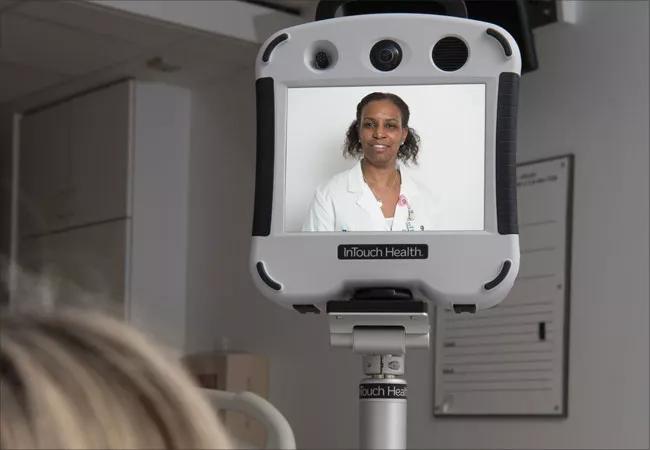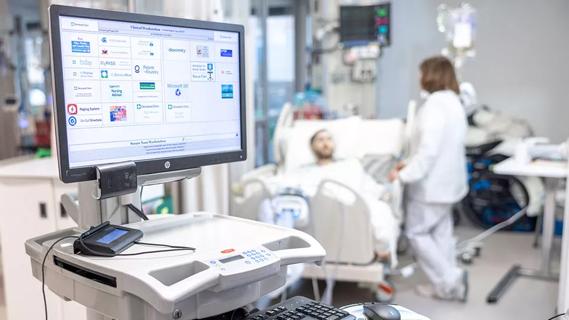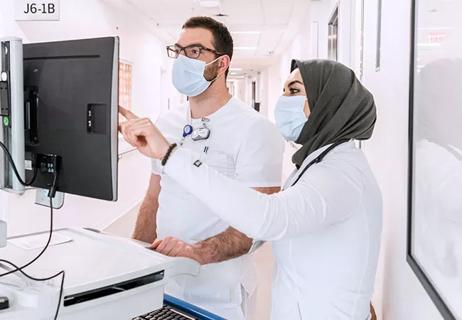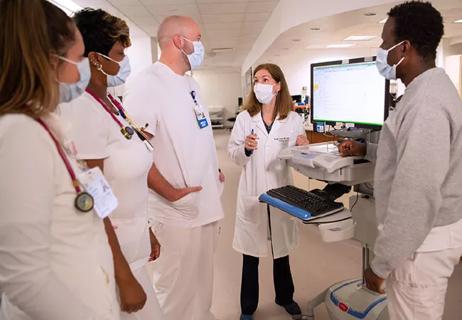Lessons learned from telemedicine pilots

Cleveland Clinic has long been expanding beyond brick and mortar healthcare, says Jeffrey Arnovitz MSN, CNP with Distance Health, a division within Cleveland Clinic’s Office of Clinical Transformation. “Distance Health is part of an initiative to transform Cleveland Clinic for the future,” he says.
Cleveland Clinic is a non-profit academic medical center. Advertising on our site helps support our mission. We do not endorse non-Cleveland Clinic products or services. Policy
In many ways, nursing is leading the way, both for outpatient visits and inpatient care.
Cleveland Clinic launched Express Care® Online in 2015. This service allows patients to schedule appointments and see providers remotely using their smartphone, tablet or computer. The service includes on demand visits (for immediate health needs) as well as scheduled follow-up visits.
Arnovitz was one of the first advanced practice nurses to see Express Care Online patients, and he’s now the coordinator. “When we’re online with patients, our goal is to deliver the same level of care we would deliver if they were in traditional in office care,” he says.
However, caring for patients remotely requires nurses to modify their skills. For example, with traditional care delivery in an office setting, you obtain a history, perform a physical exam, make an assessment, and prescribe a plan of care.
“With telemedicine, you have to modify the approach to the patient. You obtain a history, and the exam is completed virtually so this requires creative techniques,” Arnovitz says. That may mean guiding the patient to palpate their own lymph nodes or sinuses or leading the patient through their own range of motion exam.
At first this can be challenging for nurses, but Arnovitz notes that his colleagues have become skilled at delivering digital healthcare.
On the regulation side, state laws have been a barrier for telemedicine and remote prescribing, but things are changing. “The laws are catching up to this new level of practice,” Arnovitz says, noting licensure can still be an issue. (He is currently licensed in 13 states.)
Patient satisfaction with using Express Care Online is very high, according to a survey Arnovitz and his colleagues conducted. They measured key metrics such as ease of access, ease of use, time savings, and overall satisfaction with the service.
Nearly 80 percent of patients who used the service and participated in the survey said they would use it again, and on a scale of one to 10 (10 being most likely) for recommending Express Care Online, 62 percent gave it a 10.
“Care is delivered when and where patients want it, without leaving home. They don’t have to sit in a waiting room, or deal with the other ‘soft costs,’ like parking, childcare or missing work,” Arnovitz says.
“Last year, the nursing institute started to dip its toe in the telehealth waters for our inpatients,” says Nelita Iuppa, ACNO, with Cleveland Clinic’s Office of Nursing Informatics.
In 2017, her department completed two pilot programs, one with the acute pain management service (APMS) and one with wound care.
“We partnered with APMS to shorten turnaround time for seeing patients,” says Marlene Oblak, RN, nurse specialist for Nursing Informatics. The time between when an on-call doctor was paged and when he or she arrived at a patient’s bedside averaged 32 minutes.
The APMS pilot aimed to reduce time and facilitate communication by using remote technology to let doctors and patients connect. Nurses rolled a cart outfitted with a computer monitor to the patient’s bedside, and then initiated the connection with the doctor. On the other end, the doctor could talk to the nurse and the patient via computer, smartphone or tablet.
“It reduced the amount of time patients had to wait for a new pain intervention by 25 minutes,” Oblak says. She notes that it was also a great collaboration between nurses and physicians as they worked together on treatment plans for complex epidurals and patient care assessments.
The second pilot was a partnership between the main campus wound care consult team and the nursing staff at Fairview Hospital’s medical and surgical intensive care units.
“The Fairview Hospital team wanted to be able to evaluate patients more quickly, to be able to have someone look at the wound and start initial treatment until the patient could be seen in person by a wound care nurse on-site at Fairview,” Oblak explains. During communication, main campus wound care nurses were equipped with an iPhone®, and the Fairview nurses used the rolling telehealth cart at the patient’s bedside. Initially, they struggled to maneuver the monitor and get it close enough for the main campus nurse on the other end to clearly see the wound. Nursing Informatics staff eventually added an adjustable arm to the telehealth carts, which improved the process.
“We were able to shorten the amount of time for patients to be seen,” Oblak says. Also, skin assessment and staging of wounds by the wound care nurse at main campus [that was completed via telehealth] consistently matched the assessment of the in-person Fairview wound care nurse. Thus, the methodology was accurate and trustworthy.
However, there were some drawbacks to the program, Oblak says. “Our nurses loved the concept and could see the benefit, but found the process challenging.” Fitting the telehealth equipment into their workflow was tricky, and often required greater numbers of nurses to make the equipment function properly and be helpful (such as having one nurse to maneuver the monitor, another to hold the patient and one to complete the patient assessment).
Because of high patient acuity, the ICU patient population may not have been the ideal setting. “It’s a great technology, but we’re still trying to find the right fit to enhance care for inpatients,” Oblak says.
Dr. Iuppa is very optimistic about the future of telehealth, noting that the pilots play an important role, because these evaluations help everyone learn, and also help make the case for building out the infrastructure for telehealth on inpatient units.
“Currently, the infrastructure isn’t there to integrate telehealth capabilities into a patient’s room. But nurses like the efficiency of the process, and we can already see that telehealth is a great tool for facilitating quick-answer types of scenarios,” Dr. Iuppa says.
There are two nursing telehealth initiatives Dr. Iuppa hopes to put into place this year.
The first is to use telehealth technology to enable more seamless handoff between nurses and to better engage patients. “If we think about patients who need to be admitted from the ED into the hospital, for example — telehealth could help them connect with their upcoming nurse and understand more why they are being admitted, making a smoother transition,” Dr. Iuppa says. Nurses can use the technology to connect with one another as well, which can enhance direct communication and improve inter-departmental dialog.
The second program is a dial-an-expert-nurse initiative for nurses who need a mentor in any given situation. “Newer nurses could use this to ask more experienced nurses questions, or it can be used when nurses need help with patients or procedures. The expert nurse could be a support person that guides them through processes and provides tips. Ultimately, both nurses and patients benefit,” she says.
Although hands-on care is often irreplaceable, virtual care creates value by saving time, creating efficiencies, enhancing clinical care and facilitating long-distance connections. “We’re laying the groundwork for the future of virtual healthcare,” Dr. Iuppa says. “Our resources are mobile, our patients are mobile and we need to be flexible and creative in managing healthcare.”

Customized bots improve speed, efficiency by streamlining daily clinical, clerical tasks

How healthcare technology is reshaping the clinical experience for nurses and patients alike

Analysis leads to faster, more user-friendly patient records

Technology is a valued member of the care team

Nursing informatics career brings together love of computer science and patient care

Pre-recorded audio messages reduce readmissions and more

Nurses welcome machines as newest member of care team

Agility is key to implementing new technologies